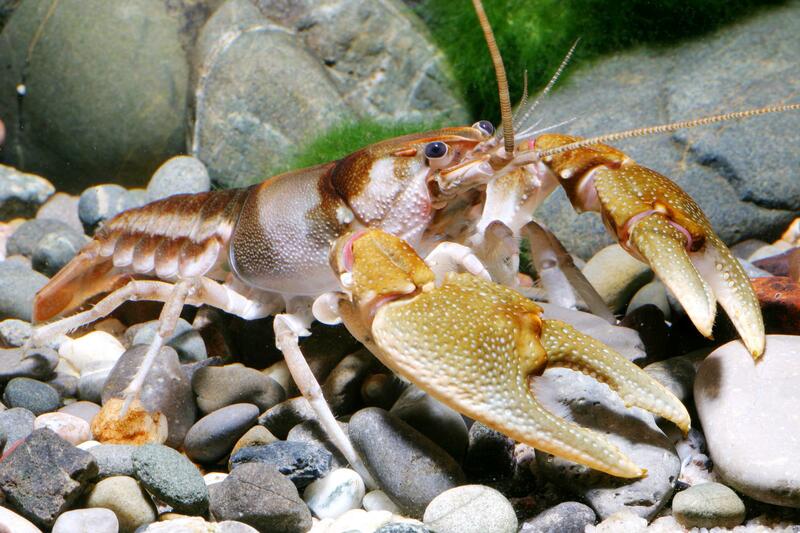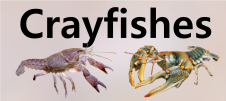







Loading profile. Please wait . . .
Cambarus girardianus Faxon, 1884
Tanback Crayfish




Federal Protection: No US federal protection
State Protection: No Georgia state protection
Global Rank: G5
State Rank: S4
Element Locations Tracked in Biotics: No
SWAP 2015 Species of Greatest Conservation Need (SGCN): No
SWAP 2025 Species of Greatest Conservation Need (SGCN): No
2025 SGCN Priority Tier: None
Element Occurrences (EOs) in Georgia: 0
Habitat Summary for element in Georgia: Associated with rocks or woody debris in flowing and quiet areas of small streams to medium-sized rivers
The Tanback Crayfish is distinctly patterned. There is a dark brown band on the head region in front of the areola and another dark brown band at the rear of the carapace which creates a saddled appearance. The areolar region is tan to brown. There is a broad, dark brown stripe down the center of the abdomen which narrows posteriorly. On each side of this dark stripe are pale stripes which are in turn flanked laterally by thinner dark stripes along the edges of the abdomen. The fingers of the claws have a gap between them when they are closed and there is typically a patch of hairlike setae at the base of the fixed finger of the claw. There is a single row of tubercles along the mesial margin of the palm and the areola is wide. The edges of the rostrum are orangish-red and the rostrum may or may not have marginal tubercles or spines. A single cervical spine or tubercle is usually present. This species reaches a maximum total body length of about 86 mm (3.4 in).
The combination of gaping fingers of the claws and the broad dark stripe down the center of the abdomen separates the Tanback Crayfish from all species with which it occurs in Georgia.
The Tanback Crayfish is a stream dweller and can be found in small spring runs less than 1-m wide to the mainstem of medium-sized rivers like West Chickamauga Creek. It can be found in swiftly flowing waters as well as quieter areas and is usually associated with rocks or other debris.
No studies of the Tanback Crayfish are known. Crayfishes are considered opportunistic omnivores and likely feed on live and decaying vegetation, aquatic insect larvae, small fishes, and dead animal matter.
Stream dwelling crayfishes typically hide during the day and come out at night to feed. Reproduction usually occurs during the spring and fall, but males in reproductive condition may be found at any time during the year. When female crayfish are ready to lay eggs, they usually find a secure hiding place and hence are rarely encountered. When the eggs are released, the female attaches them to her swimmerets and is said to be "in berry." Upon hatching, the juvenile crayfish are attached to the mother by a thread. After the juveniles molt for the second time, they are free of the mother, but stay close and will hold on to her for some time. Eventually they move off on their own. Crayfishes molt 6 or 7 times during their first year of life and most are probably able to reproduce by the end of that year. They molt once or twice a year for the remainder of their lives and live about 3 years. Male Tanback Crayfish in reproductive condition have been collected in April, May, October, and November and 7 females carrying eggs were found in April. The smallest male from Georgia is about 48 mm (1.9 in) and the smallest female with eggs is about 51 mm (2 in). Numbers of eggs ranged from 83 to 224 (Hobbs 1981).
Since this species is usually found in flowing water, it is most easily collected by holding a net perpendicular to the current downstream of a large rock, then lifting the rock and disturbing the substrate beneath it. If a crayfish is hiding underneath the rock, it will likely move into the net. Shocking downstream into a seine net with a backpack electroshocker is also effective. In quieter areas of the stream, rocks can be turned gently, and after the water clears either pin the crayfish by hand or coax it into a dipnet. Using a backpack electroshocker or baited minnow traps set overnight are effective as well.
The Tanback Crayfish inhabits the upper-middle and upper Tennessee River system in Alabama, Georgia, Mississippi, and Tennessee. In Georgia it is known only from Tennessee River tributaries in the northwestern portion of the state (Hobbs 1981, 1989).
Heavy sedimentation resulting from poor development and land management practices may cover substrates and other daytime hiding places on which crayfishes rely to avoid predation. The introduction of non-native crayfishes is a threat to all native crayfishes.
This species common and widespread and is apparently stable in Georgia.
Conserving populations of the Tanback Crayfish will require general watershed level protection measures, including the protection of riparian zones, control of sediment and nutrient runoff from farms and construction sites, and limiting the amount of impervious cover (e.g., pavement) within occupied watersheds. Non-native crayfishes should never be used for bait; instead, anglers should use crayfishes collected from the river system where they will be fishing. Unused bait of any kind should not be released back into Georgia waters.
Hobbs, H.H., Jr. 1981. The crayfishes of Georgia. Smithsonian Contributions to Zoology 318:1–549.
Hobbs, H.H., Jr. 1989. An illustrated checklist of the American crayfishes (Decapoda: Astacidae, Cambaridae, and Parastacidae). Smithsonian Contributions to Zoology 480:1–236.
Taylor, C.A., G.A. Schuster, J.E. Cooper, R.J. DiStefano, A.G. Eversole, P. Hamr, H.H. Hobbs III, H.W. Robison, C.E. Skelton, and R.F. Thoma. 2007. A reassessment of the conservation status of crayfishes of the United States and Canada after 10+ years of increased awareness. Fisheries 32:372–389.
Christopher E. Skelton
C. Skelton, 2012: original account
C. Skelton, February 2019: general update of account.